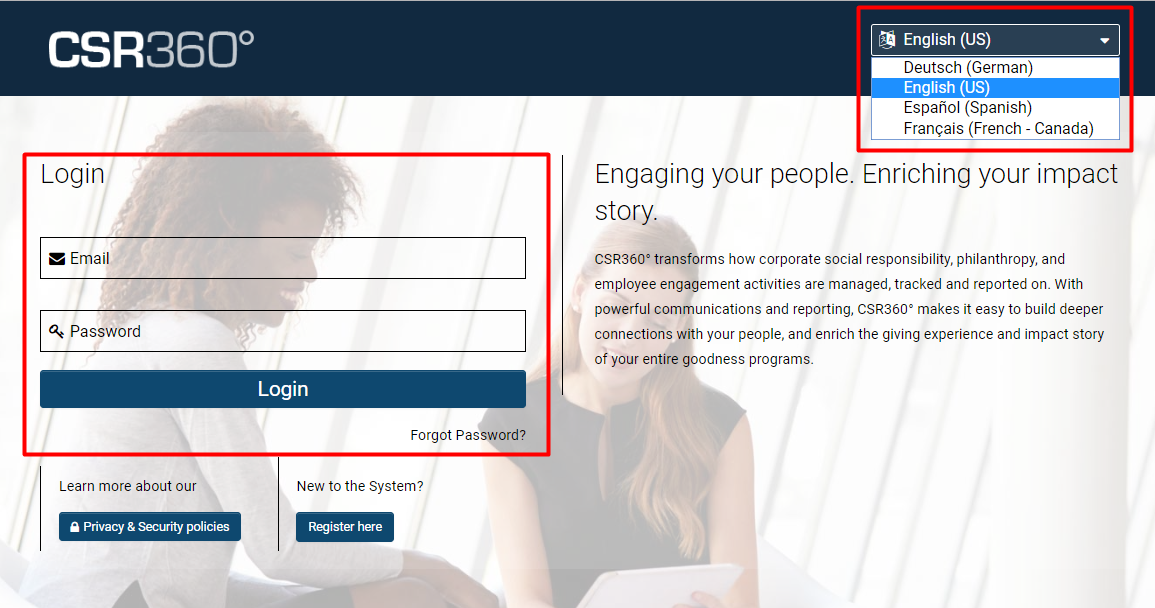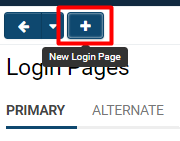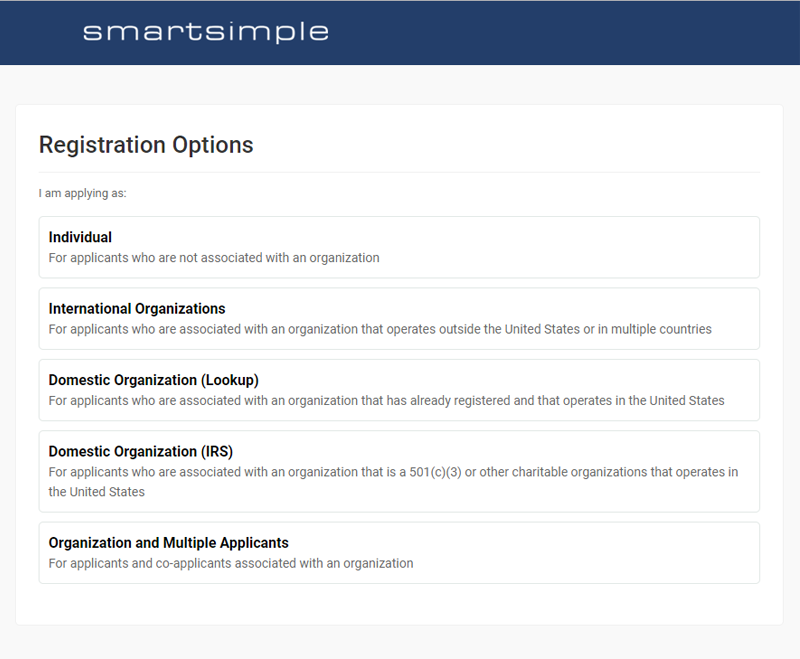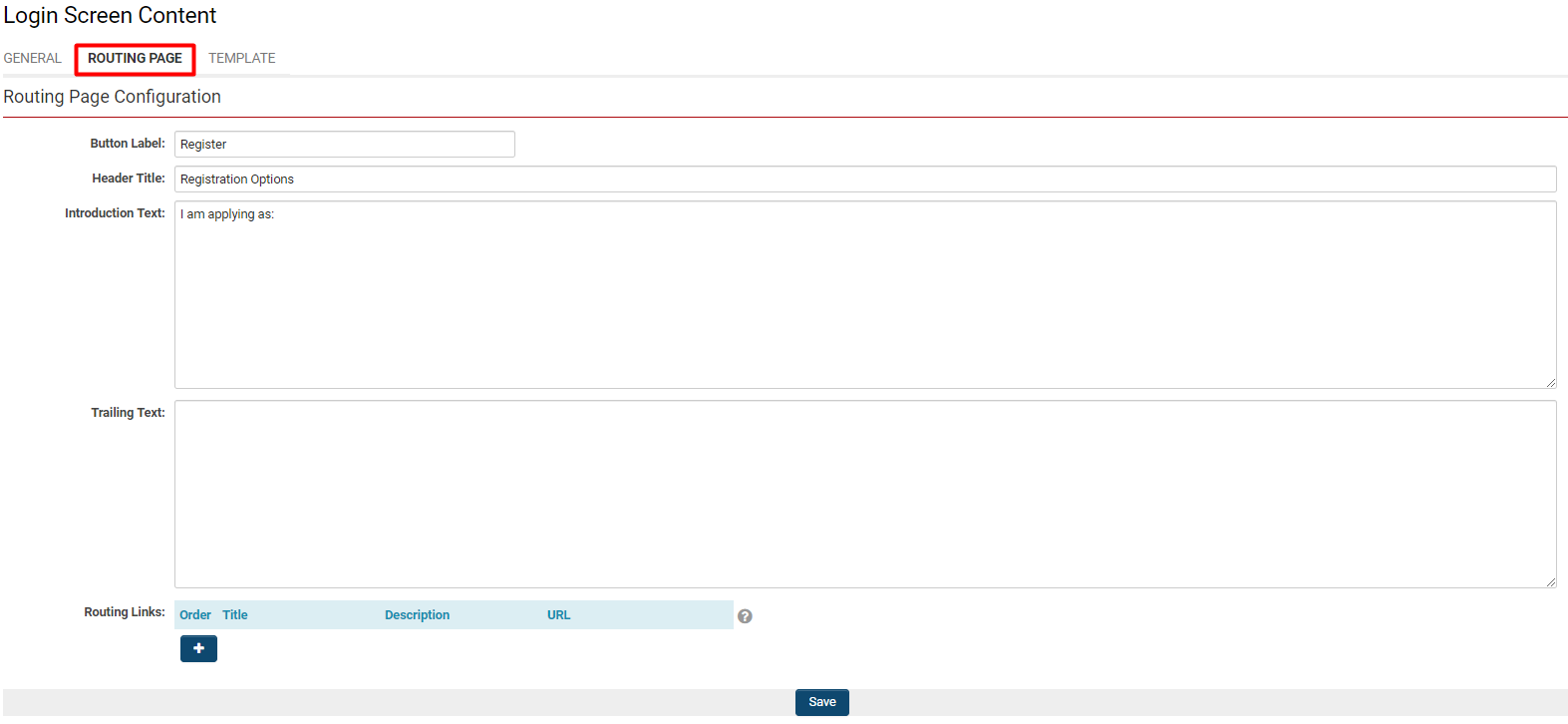Login Page
Contents
Overview
The Login page allows a user to gain access to your SmartSimple System. The user will authenticate on this page, typically by entering a username and password. You will need Global Administrator access to setup or edit login pages.
The login page is used to:
- Authenticate the user
- Switch languages
- Direct people to a signup page via the (routing page)
- Ask the user to accept the use of cookies
- Enforce agreement of your systems privacy and security policies.
- Reset your password
This article will show you how to setup and modify login pages within your system and we will look at other related settings.
Configuration - Essentials
Creating a New Login Page
1. Click on the 9-square menu icon on the top right of your page.
2. Under the heading Configuration, select Global Settings.
3. Click on the Branding tab.
4. Click on Login Pages.
5. The list of login pages available in your system will be displayed under the Primary tab; if there are none, the list will be empty.
6. Staying on the Primary tab, click the + icon in the action bar to create a new Login Page.
7. Modify the settings on the General tab and press Save.
Multiple/Switching Languages
Administrators need to create a separate login page for each language you want to support. You choose the desired language for a login page when you create a new login page.
If you have more than one language login page, the user will see a drop down in the top right of the screen. The user can choose their desired language from this drop down.
Administrators can choose which language login page is the default via a toggle on the settings page for the desired log in page.
You can also send your users a direct link to a specific language login page. For example, if I wanted to send users to a configured Spanish language login page I would adding ?&lang=14 to the login page and send that URL to a user. the URL would look like this:
https://myalias.smartsimple.com/s_Login.jsp?&lang=14
Creating a Routing Page
Routing pages are created to direct (guide) the end user to the appropriate page which is typically a Signup page. When a user navigates to a login page they will click a button which is typically labeled register on the login page and that will take the user to an intermediary (routing) page where they can see the list of available signup pages.
Routing pages are recommended if you have:
- Multiple signup pages to register different kinds of organizations and users
- Multiple signup pages for different languages
- Multiple eligibility questionnaires
To create a routing page
- Go to Menu Icon > Global Settings > Branding tab > Login Pages link > edit the desired login page > Routing Page tab.
- Under Routing Links press the plus button.
- For Title enter some text to indicate the kind of signup page you will link to. Example Individual, Domestic Organization, International Organization, etc.
- For Description enter some text to help people choose the correct signup page. Example, the description for a user signup page might be For applicants who are not associated with an organization.
- For URL enter the URL to your signup page or use the lookup to find it. If you paste the Page URL of your signup page into a routing page, make sure you use the relative path example: /s_csignup.jsp?token=XVtQHUUGYVpQRhRRXxNRS1BWZEl2HnFsFA%3D%3D&ptoken=XVtQC1oGYVpQRhRRXxNRS1BWZEl2HnFsFQ%3D%3D. Relative paths will resolve correctly and work on production as well as development/backup.
- Press Save.
Agreeing to Cookies
When we talk about Cookies we are referring to a small piece of data stored on a user’s computer. As of the Cookie directive users must be aware/consent to cookies.
The first time a user comes to your system they will be presented with an alert explaining that SmartSimple uses cookies. It also states that by using the system they are consenting to the use of cookies. The user can click OK to accept or navigate away. There is also a link to a longer description which explains what cookies are being used and why.
We recommend that you should leave this setting always on, However it is possible to disable the cookie warning. Go to Menu Icon > Global Settings > Security and toggle off Enable Cookie Usage Acceptance.
Privacy and Security Policies
Within your system you will need to setup Privacy and Security Policies. You will set these polices up for several language and country combinations. Typically a privacy policy will say what type of information you collect, why it is collected, how it is collected , what you will use the information for, who will have access to the information, how users will be notified of changes to the policy and who to contact regarding privacy concerns.
Learn more about Configuring Privacy and Security Policies
The login page will have a button called Privacy & Security Policies in the main panel below the email and password inputs.
If you have chosen a date for Enforce User Acceptance the user will be brought directly to your policies upon login.
Settings Explained
The following settings are available on the General tab:
| Setting | Description |
|---|---|
| Language |
Each login page must have a single language which you can select from the drop down. Available languages are:
|
| Is Default Login Page | By default, when a user goes to your system's URL, example https://smart.smartsimple.com they will be directed to the English US language login page. If you want users to go to a different language login page by default, toggle this setting on for the login page with your desired language. Note: only one login page can be set as the default. |
| Page Title | Text entered here will display in a browsers title bar or a page’s tab. This text is used as the title tag of your web page. |
| Login Title | Text entered here appears above the area where you authenticate. Generally it is not modified. |
| Content Title | Text entered here appears above the custom message on the right area of the screen. Typically this is replaced with something like Welcome to ABC System. |
| Content Text | Text entered here appears below the content title. Typically this area is used to describe who you are, what you do and what the system is used for. Example, ABC group provided grants to non-profits in small town USA. Press the register button to gain access to the system and apply for funding. |
| Logout Redirect URL | Enter a URL such as https://www.smartsimple.com/ here and the user will be redirected to that site upon logout. |
| Link Section |
Typically people are given the ability to self-register and gain access to your system. You have 3 options in this regard. None – You provide no links to a signup page. Users cannot self-register and must be created and activated in your system via a different methodology, such as auto loading, importing or manual creation by internal staff. Use Routing page – When you have multiple signup pages for different types of users, organizations and languages, this option is used. It will display a list of signup pages so the user can be directed to the signup page that is right for them. Learn more about routing pages Custom URL – If you only have one signup page in one language you can choose this option and enter the URL to that page here. Remember to use the relative path. Example /s_signup.jsp?token=XVtQC1oGYFFaRhNaXxJaQVBRZEl8GnA%3D this way the register button will work on production and backup and any staging servers you may have. |
| Link Section Title | Text entered here appears above the register buttons. Typically this is not modified. |
The following settings are available on the General tab, Page Formatting section:
| Setting | Description |
|---|---|
| Background Image | The image uploaded will appear behind the content of your login page (in the background). Upload an image in JPG or PNG format with a resolution of 1920 x 1080 or higher.
Browse a file from your computer using the folder icon and upload it with the upwards arrow icon. You can delete any uploaded file with the trashcan icon. Note: The background image field will only allow you to browse and upload a file once you have clicked the Save button on a new login page. |
| Background Position | Select how the image will render at different resolutions by choosing where to anchor the image vertically and horizontally. For example if you choose Top and Left as the position, then the top left area of the background image will always be visible on screen. Anything on the right/bottom of the image may not display depending on screen size and aspect ratio of the image and the users device. |
| Background Color | Adjust this setting to change the color that will appear above the background image. Enter the desired hexadecimal value here without the # or use the color picker. Example, enter FFFFFF to have a white background. |
| Background Opacity | Adjust this setting to change the opacity of the background color. For example High will make the color completely opaque and you will not see the background image. Low will make the background color completely transparent revealing the background image as uploaded. Something in between Low and High will create a translucent layer of color over the background image. |
| Panel Color | Select the color of the panel that appears behind the content such as the username and password. |
| Panel Opacity | Select the level of opacity for the panel that appears behind the content such as the username and password. Low will make the panel transparent, High will make the panel opaque. |
| Font Color | Select the color used for all text that appears on the panel. Example 'Content Title, Content Text, Link Section Title, etc. Note you must make sure there is enough contrast between the foreground text and the panel or background image. Typically text is black on a white panel or white on a black panel. |
The following settings are available on the Routing Page tab:
| Setting | Description |
|---|---|
| Button Label | The text entered here will be used as the label for the button that will open the Routing Page. This button is displayed on the login page. Typically you will enter the text Register. |
| Header Title | The text entered here will appear at the top of the routing page. Typically you will enter something like Registration Options. |
| Introduction Text | The text entered here will appear under the title but before the list of signup pages. Typically you will enter something like I am applying as:. |
| Trailing Text | The text entered here will appear under the list of signup pages. Typically you will leave this blank however some clients have chosen to add contact information here in case the user needs assistance |
| Routing Links | This dynamic section enables the administrator to add links to their desired signup pages onto the Routing Page.
To create a new link, click the + button. |
| Title | Text entered here will appear in bold for each link. Typically you would enter a few words like Individual, International Organizations, Domestic Organizations. |
| Description | Text entered here will appear below the title and is used to clarify what kind of user should click this link. Using a user signup page as a link you might enter a few words like For applicants who are not associated with an organization. |
| URL | The relative URL that the user will be taken to upon clicking on the link. You can use the lookup button to pick the desired signup page. |
The following settings are available on the Template tab but they are typically not modified:
| Setting | Description |
|---|---|
| Sample Template | Clicking this link inserts the HTML, CSS and other code which is used to render the login page. Typically you would only add the sample template in two scenarios. First you have an older custom login page and you want to update your login page to use the new look and features, or you want to create your own customized login page with a different look and feel. |
| Login Page Template | You can enter your custom code into this text area or modify the existing content added by clicking the sample template link. Although you can enter your own code here we generally don’t recommend it. If you do add your own code here make sure your code meets accessibility guidelines and make sure it is responsive (works on all devices including mobile). |






